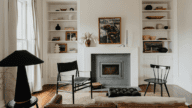Is it Better to Sell a House Furnished or Unfurnished?
- Published on
- 9 min read
-
 April Blake, Contributing AuthorClose
April Blake, Contributing AuthorClose April Blake Contributing Author
April Blake Contributing AuthorApril Blake is a freelance writer and editor, located in Cayce, South Carolina. She is a homeowner who appreciates following the real estate market in her area. April also frequently writes about food, health, wellness, and lifestyle topics; and enjoys yoga and ice cream in her free time.
-
 Richard Haddad, Executive EditorClose
Richard Haddad, Executive EditorClose Richard Haddad Executive Editor
Richard Haddad Executive EditorRichard Haddad is the executive editor of HomeLight.com. He works with an experienced content team that oversees the company’s blog featuring in-depth articles about the home buying and selling process, homeownership news, home care and design tips, and related real estate trends. Previously, he served as an editor and content producer for World Company, Gannett, and Western News & Info, where he also served as news director and director of internet operations.
It’s time to sell your home, and there are a lot of decisions to be made at all points during the process. After deciding to sell your house, it’s time to think of how to present it to potential buyers.
You can either move out before it goes on the market and sell it unfurnished as a blank canvas for future buyers to project their hopes and dreams on. Or you can give buyers a vision of how they might live in the home with furniture, art, and objects to showcase the benefits of the space with a tangible visual.
Furnished vs. Unfurnished?
The question of whether or not to sell a home furnished or unfurnished is often debated and contested among agents, sellers, and buyers. Opinions are divided over the pros and cons, of which there are many on each side. One home might highly benefit from showing future buyers how they could put their own furniture in the space, while another home may be best displayed completely unadorned.
Since the verdict on selling a house furnished versus unfurnished falls in the gray area of the real estate courtroom, the direction you choose can be very much influenced by the agent you choose to sell your home.
Find a top agent in your area who is familiar with the market and what buyers are looking for when seeking their next home. An experienced agent will be able to look at your home, lifestyle, budget, and other factors to determine whether your house will sell best when it is furnished or unfurnished.
Your agent’s expertise will guide you toward either emptying out your home to take advantage of certain aspects of the house — or perhaps they’ll encourage you to keep items like a generously sized dining table to showcase how many family members will be able to sit around the table for the holidays.
We reached out to Megan Toll, a top agent with the Kevin Toll Group in Pennsylvania that works with over 67% more single-family homes than average Drexel Hill agents. She shares the pros and cons for each side of the decision to sell a home furnished or unfurnished.
Pros of selling a furnished house
Selling a house furnished means having at least some of the rooms with furniture, decorations, and personal items still in the house. “It could be that the person is still living there and has all of their belongings there, or it could be staged furnishing,” says Toll. It is more than just having a few pieces of random furniture sitting in the house.
There are several pros to selling a house furnished, whether it is furnished with personal belongings or staged by a professional — or even a mixture of both. These are the pros to selling a furnished house:
Paints a compelling picture for potential buyers
The right furnishings can help prospective buyers envision how a space might be used. “There’s a visual bonus to having furniture already in the property for potential buyers to see how their stuff is going to fit in,” says Toll.
Enhances appeal and selling power
A furnished home can enhance and increase the appeal of the property by showing potential buyers a different idea of how a room might be used.
“If you walk into someone’s basement, and it’s a wide-open space, and they have it furnished, you can see how they break it up into a playroom, exercise space, and office area or entertainment space,” Toll says. “When the property is vacant, you might just see a large space and not understand how many different areas you might be able to designate within that one room.”
Misdirect buyers’ eyes away from flaws
A furnished and staged home can help deemphasize flaws or direct focus away from imperfections. Placing useful furniture in oddly placed nooks can show how the space can actually be useful, whereas if it was unfurnished, a buyer might not see the potential uses of visually awkward parts of the home.
Cons of selling a furnished house
The housing market has changed drastically, and houses are selling very quickly in hot markets. Depending on the market in your area, there may be little to no benefit in showcasing a home furnished.
Expensive with a questionable ROI
Furnishing or updating furnishings to help a house sell can get expensive. It can be even more so if you hire professional decorators or home stagers who bring in a lot of furniture and decor.
Time-consuming if a quick sale is the goal
If your goal is to sell your home quickly and get moved into your new home, selling a furnished house can be difficult for the homeowner.
“We could be settling in as little as two weeks if it’s a cash deal, which is a very fast turnaround,” says Toll. In cases where she expects this, she often advises homeowners to sell the house unfurnished so they are not hurried to pack and move once the home sells.
Buyers notice the belongings more than the space
While leaving furnishings in a home can misdirect and refocus buyer attention away from flaws, sometimes the stuff in the home is distracting. This is why depersonalizing a home is important. “Too many people get caught up checking out your pictures or personal tastes versus imagining themselves living in the home,” says Toll.
Potential for damaged items
Selling a house furnished, whether it’s your own belongings or staged furniture, means there’s a possibility of damage. Damage can occur when people come through the home or when items are moved in or out.
Pros of selling an unfurnished house
An unfurnished house typically means everything is vacant and nothing is inside the property. This can be because the house was vacant to begin with, or the property was recently vacated and the owners took all of their belongings with them. Toll recommends an unfurnished house be completely empty, with no leftover pieces of furniture for potential buyers to wonder if they will get stuck with unwanted items.
Faster selling preparation
When the home is unfurnished, it can be ready to sell faster. Dusting, vacuuming, wiping down walls, and other cleaning tasks are much easier when you are not working around stuff.
“If you have thirty years’ worth of belongings in your home, it’s going to take a lot of time just to prepare your home for selling,” says Toll. “It takes much longer than a property that might be vacant or already cleared out.”
More affordable
It is typically less expensive to sell a house if you don’t have to purchase new furnishings or clean existing furnishings. You also eliminate the expense of hiring decorators or professional stagers, which can add costs and fees that eat into your potential profit on the home sale.
Shows off open space and home design
An unfurnished home can more effectively present the home’s open spaces and architecture. Some buyers will appreciate seeing and imagining the full potential of the space through their own eyes rather than seeing other people’s belongings cluttering up their vision.
Cons of selling an unfurnished house
Looking at it from another perspective, there can be drawbacks to selling an unfurnished home. The weight of the drawbacks will largely depend on the qualities of your home, the market, and the makeup of your buyer pool.
Flaws and imperfections openly exposed
Without furnishings to distract or disguise flaws, cracks, uneven walls, chipped molding, scuffs, and scratches are all open and exposed to the buyer’s eye. This can give the impression that a home has not been properly cared for.
Home may feel lifeless and dull
Walking into an unfurnished home might convey a hollow emptiness that feels void of life. “Certain types of buyers need to see it in place, and they might have a bit more difficulty visualizing,” says Toll.
Hard to imagine
Conceptualizing space, especially without a tape measure or pre-existing furniture, is not easy for some people. “If people don’t have a good concept of space to see if a king-size bed and two nightstands are going to fit in the master bedroom, they may have a hard time knowing how or if those items will fit,” says Toll.
Virtual staging: an alternative that combines both options
An alternative to selling a home furnished or unfurnished is virtual staging. Virtual staging is when professional real estate photography is combined with digital images of furniture and furnishings to show off a space — all virtually.
When a potential buyer goes into the house, there may be no furniture, but they can look at the digitally enhanced photos to see what the house would look like furnished. “It gives a better sense of how the space can be used since it might be difficult to determine how the property is set up,” says Toll.
See examples of virtual staging at this link.
Toll points out that many clients don’t even know virtual staging is an option. “When we are able to do that, they are very pleased with the results because they don’t have to worry about the timeline of getting furniture in or out when we have quick settlements,” she says.
If you’re interested in this option for your home sale, ask your agent if they work with virtual stagers. Top agents in your area who are familiar with virtual staging will have connections to people who can create a virtually staged home if that will best fit your home-selling situation.
Should I sell furnished or unfurnished? It depends on your selling objectives
There are pros and cons to each side of selling a home furnished or unfurnished, but it all primarily comes down to what will help the home sell best. The seller’s situation, finances, and preferences also come into play when deciding what will bring success. The expertise and guidance of the top agent you choose for your home selling journey will be able to help you decide.
Thanks to technological advances, you can also try virtual staging, which allows you to present the best parts of your home to a potential buyer without lifting a finger — until it’s time to actually move!
HomeLight’s free Agent Match platform can connect you with a top-performing agent in your market who can assess your needs and home to determine whether you should sell your house furnished, unfurnished, or virtually furnished.
Header Image Source: (Jacob Sutherland/ Unsplash)




